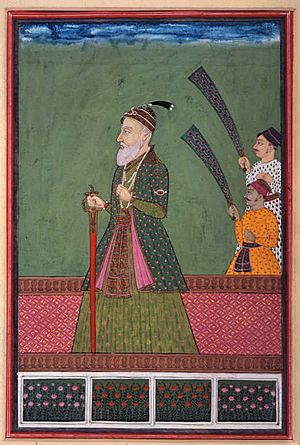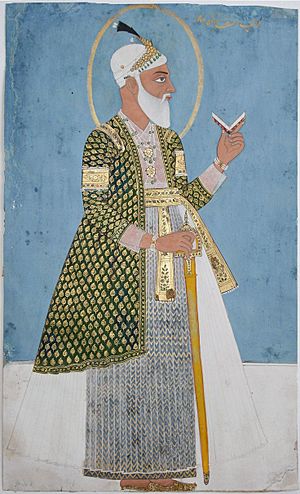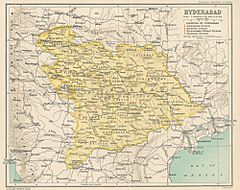Nizam-ul-Mulk, Asaf Jah I facts for kids
Quick facts for kids
Asaf Jah I
|
|
|---|---|
| Chin Fateh Khan Chin Qilich Khan, Nizam-ul-Mulk Asaf Jah Khan-i-Dauran Bahadur Khan-i-Khana Fateh Jung Firuz Jang Ghazi-ud-din Bahadur Amir-ul-Umara Bakhshi-ul-Mumalik |
|

Nizam-ul-Mulk
|
|
| 1st Nizam of Hyderabad | |
| Reign | 31 July 1724 – 1 June 1748 |
| Predecessor | Position Established |
| Successor | Nasir Jang Mir Ahmad |
| Full name |
Mir Qamar-ud-din Khan Chin Qilich Siddiqi Bayafandi Nizam-ul-Mulk Asaf Jah I
|
| Years active | c. 1677 – 1748 |
| Born | 11 August 1671 Agra, Mughal India |
| Died | 1 June 1748 (aged of 76) Burhanpur |
| Buried | Khuldabad (near Aurangabad), Hyderabad State, Mughal India (now in Maharashtra, India) |
| Noble family | Asaf Jahi Dynasty |
| Spouse(s) | Umda Begum, Said-Un-Nissa Begum |
| Issue | Firuz Jung Nasir Jung Salabat Jung Asaf Jah II Basalat Jung Humayun Jah 7 daughters |
| Father | Nawab Ghazi ud-Din Khan Feroze Jung I Siddiqi Bayafandi Bahadur (Farzand-i-Arjumand)Ghazi Uddin Siddiqi. |
| Mother | Wazir un-nisa Begum |
| Military career | |
| Allegiance | |
| Service/ |
Nizam of Hyderabad |
| Rank | Sowar, Faujdar, Grand Vizier, Subadar, Nizam |
| Battles/wars | Mughal-Maratha Wars Nader Shah's invasion of the Mughal Empire Battle of Karnal |
Mir Qamar-ud-din Khan Siddiqi Bayafandi (born August 11, 1671 – died June 1, 1748) was a very important leader in India. He was also known as Chin Qilich Qamaruddin Khan, Nizam-ul-Mulk, and Asaf Jah. He became the first ruler, or Nizam, of the Hyderabad State.
He started his career working for the powerful Mughal emperor Aurangzeb. After Aurangzeb died in 1707, there was a lot of fighting among his sons. Asaf Jah stayed neutral. When Bahadur Shah won, Asaf Jah was made governor of different areas. In 1714, he became the Viceroy of the Deccan, which meant he was in charge of six Mughal provinces in southern India.
Later, he helped the new Mughal emperor, Muhammad Shah, get rid of some powerful people called the Sayyid brothers. For this, he was rewarded and became the Grand Vizier (like a prime minister) from 1722 to 1724. However, disagreements with the emperor led him to leave Delhi. In 1724, he declared himself the Nizam and started the Asaf Jahi Dynasty, which ruled Hyderabad for a long time.
Contents
Who Was Asaf Jah I?
Mir Qamar-ud-din Khan, also known as Nizam, was the son of Ghazi ud-Din Khan Feroze Jung I and Wazir un-nisa Begum. His mother was the daughter of Sadullah Khan, who was a very important minister (Grand Vizier) for the Mughal Emperor Shah Jahan. Shah Jahan was the emperor who built the Taj Mahal.
Asaf Jah's family had a long history of serving important rulers. His great-grandfather, Alam Sheikh, was a respected Sufi saint from Bukhara (in modern-day Uzbekistan). His grandfather, Kilich Khan, came to India from Samarkand (also in Uzbekistan) in 1654. He joined the army of Aurangzeb and fought in important battles.
Asaf Jah's father, Ghazi ud-Din Khan Feroze Jung I, also came to India and joined Aurangzeb's army. He became a general and later the governor of Gujarat. So, Asaf Jah came from a family of brave soldiers and important officials.
His Early Life and Military Career
Mir Qamar-ud-din Khan was born on August 11, 1671, in Agra. Emperor Aurangazeb himself gave him his name. Both his grandfathers were important people in the Mughal court.
He was educated privately and learned many skills. He was a skilled warrior from a young age. When he was just six, he went with his father to the Mughal court. By the time he was a teenager, he was fighting alongside his father in battles.
Becoming a Young Swordsman
In 1688, at age 17, he helped capture the fort of Adoni. For his bravery, he was promoted and given a fine Arabian horse. In 1690, when he was 19, Emperor Aurangzeb gave him the special title Chin Qilich Khan, which means "boy swordsman."
He continued to show his military skills. In 1693, he defeated the Marathas at Karad. In 1698, he helped stop a revolt near Bijapur. He was promoted again for his success.
Capturing Panhala Fort
In 1699, Asaf Jah was promoted to an even higher rank. He successfully surrounded and captured the Panhala Fort, which was held by the Marathas. He cut off all supplies to the fort, and it fell to his forces in June 1700. Because of his excellent service, Aurangzeb made him the faujdar (garrison commander) of Bijapur.
His Career and Rise to Power
After Emperor Aurangzeb died in 1707, the Mughal Empire started to weaken. A powerful family known as the Sayyid brothers became very influential. They were known as "king-makers" because they decided who would be the next emperor.
Dealing with the Sayyid Brothers
The Sayyid brothers caused a lot of conflict in the Mughal court. They would remove one emperor and appoint another. After several quick changes, Muhammad Shah became emperor in 1719, with the Sayyid brothers as his main advisors.
Asaf Jah was first appointed Governor of Oudh. In 1714, he became the Viceroy of the Deccan, given the title Nizam-ul-Mulk (Administrator of the Realm). He was also called Fateh Jung (Conqueror of Battles).
From 1719 to 1722, Asaf Jah worked to remove the Sayyid brothers from power. He gathered support from other nobles. In 1720, he captured important forts and defeated the Sayyid brothers' forces in the Deccan. With Asaf Jah's help, Emperor Muhammad Shah had the Sayyid brothers killed by 1722.
Becoming Grand Vizier
As a reward for his help, Asaf Jah was made the Grand Vizier (Prime Minister) of the Mughal Empire in 1722. He tried to fix the corruption in the court, but this made him many enemies.
His growing power also worried Emperor Muhammad Shah. In 1723, the emperor tried to move Asaf Jah away from Delhi. But Asaf Jah refused and marched towards the Deccan. The emperor then ordered Mubariz Khan, the Governor of Hyderabad, to stop Asaf Jah.
The Battle of Shakar Kheda
This led to the Battle of Shakar Kheda in 1724. Asaf Jah I defeated Mubariz Khan. After this victory, the Mughal emperor had to accept Asaf Jah as the permanent Viceroy of the Deccan.
Establishing the Hyderabad State
On October 11, 1724, Asaf Jah I declared his independent rule over the Deccan region. This marked the beginning of the Asaf Jahi dynasty. Even though he was now an independent ruler, he remained loyal to the Mughal Emperor in name. He did not take on any imperial titles himself.
He gained control over all six Mughal governorates in the Deccan, making them part of his new state. The rulers who came after him continued to use the titles Nizam ul-Mulk and Asaf Jah. They were known as the Nizams of Hyderabad.
Conflicts with the Marathas
As a new ruler, the Nizam wanted to strengthen his state and control the growing power of the Marathas. In 1725, he refused to pay the Marathas the taxes called Chauth and Sardeshmukhi. This led to a war that lasted from August 1727 to March 1728.
The Nizam was defeated by Bajirao I, a Maratha leader, at the Battle of Palkhed near Nashik. He then signed a treaty with the Marathas, which allowed them to collect taxes in the Carnatic region.
In 1737, Maratha forces gathered near Delhi. The Nizam marched from the Deccan to stop them. This led to the Battle of Bhopal. A peace treaty was signed in January 1738, and both sides returned to their regions.
Organizing His Kingdom
The Nizam divided his new kingdom into three parts. One part was his private land, called the Sarf-i-Khas. Another part was for government expenses, known as the Diwans territory. The rest was given to nobles, who would collect taxes from villages and pay gifts to the Nizam. The most important of these were the Paigah estates, whose members also served as generals.
Facing Nader Shah's Invasion
In 1739, a powerful ruler named Nader Shah invaded India from Persia, advancing towards Delhi. The Mughal Emperor Muhammed Shah gathered his forces at Karnal to fight Nader Shah.
Asaf Jah I sent his troops to join the Mughal army. However, the Mughal forces were defeated by Nader Shah's army, which had better weapons and tactics. During the battle, the Nizam stayed back with a part of the army. He believed it was pointless to fight such a strong enemy and wanted to save his men.
Saving Delhi
Nader Shah entered Delhi and his soldiers were stationed there. When some locals attacked his soldiers, Nader Shah became furious and ordered a massacre. The helpless Emperor Muhammad Shah and his ministers were too afraid to speak to Nader Shah.
Asaf Jah I bravely stepped forward and risked his life. He went to Nader Shah and asked him to stop the killing in the city. His words had a great impact on Nader Shah, who ended the massacre and returned to Persia.
Later Life and Legacy
Asaf Jah I was a good ruler for his own territory. He kept the administration well-organized.
In 1742, the British, who were based in Madras, sent him gifts to show their respect. In return, the Nizam sent a horse and jewelry, and warned the British that they could not mint their own money, which they agreed to.
Just before he died in 1748, Asaf Jah wrote his last will. It had 17 rules for how to govern and behave. He advised his successors to keep their troops happy and to always respect the Mughal Emperor. He also warned them against unnecessary wars and to avoid listening to gossip.
The Future of Hyderabad
Nizam-ul-Mulk is remembered for creating one of the most important Muslim states outside the Middle East. Hyderabad State continued to exist throughout the period of British rule in India. It was the largest and one of the richest princely states in India when India gained independence in 1947. When the first Nizam ruled, his territory was as large as France.
The titles "Nizam Ul Mulk" and "Asaf Jah" were given to him by the Mughal Emperors. These titles carried on his legacy, as his descendants ruled under the title of "Nizam of Hyderabad," and the dynasty became known as the Asaf Jahi Dynasty.
Family Life
Asaf Jah was married to Said-Un-Nissa Begum. They had four children: two daughters and two sons, Ghazi-ud-din Feroz Jung and Nasir Jung (who later became Nizam). He had four more sons from other wives: Salabat Jung (later Nizam), Nizam Ali Khan (later Nizam), Basalat Jung, and Mogal Ali Khan.
After Asaf Jah I died in 1748, there was a period of political trouble. His sons and grandson fought for the throne. This fighting led to European powers like the French and British getting involved in Indian politics. This involvement eventually led to the British dominating India.
His Death
Asaf Jah I was constantly traveling to manage his large territory and deal with conflicts. In May 1748, he arrived in Burhanpur and became ill. Realizing he was going to die, he wrote his last will with his family and close friends present.
He died on June 1, 1748, at the age of 77, in Burhanpur. He was buried at the shrine of Shaikh Burhan ud-din Gharib Chisti in Khuldabad, near Aurangabad. This is also where his mentor, Emperor Aurangazeb, is buried.
His death led to a time of instability. His sons and grandson fought for the throne, supported by other states and foreign powers. The rule of Asaf Jah II, who reigned from 1762 to 1803, finally brought stability back to Hyderabad.
Titles and Positions
Asaf Jah I held many important titles and positions throughout his life:
- 1697: Chin Qilich Khan (given by Emperor Aurangazeb)
- 1713: Khan-i-Khanan, Nizam ul-Mulk, and Fateh Jang (given by Emperor Farrukhsiyar)
- 1737: Asaf Jah (given by Emperor Muhammad Shah)
- 1739: Amir ul-Umara and Bakshi ul-Mamalik (Paymaster-General)
He served as:
- Faujdar (garrison commander) of various regions like the Carnatic and Bijapur.
- Subedar (governor) of important provinces like Oudh, the Deccan, Patna, Malwa, and Gujarat.
Military Ranks
Asaf Jah I steadily rose through the military ranks:
- 1684: Commander of 400 foot soldiers and 100 horsemen.
- 1698: Commander of 3,000 foot soldiers and 500 horsemen.
- 1702: Commander of 4,000 foot soldiers and 4,000 horsemen.
- 1705: Commander of 5,000 foot soldiers and 5,000 horsemen.
- 1713: Commander of 8,000 foot soldiers and 8,000 horsemen.
- 1722: Commander of 9,000 foot soldiers and 9,000 horsemen.
|
Nizam-ul-Mulk, Asaf Jah I
Asaf Jahi dynasty
|
||
| Preceded by None |
Nizam of Hyderabad 1720 – 1 June 1748 |
Succeeded by Nasir Jang Mir Ahmad |



